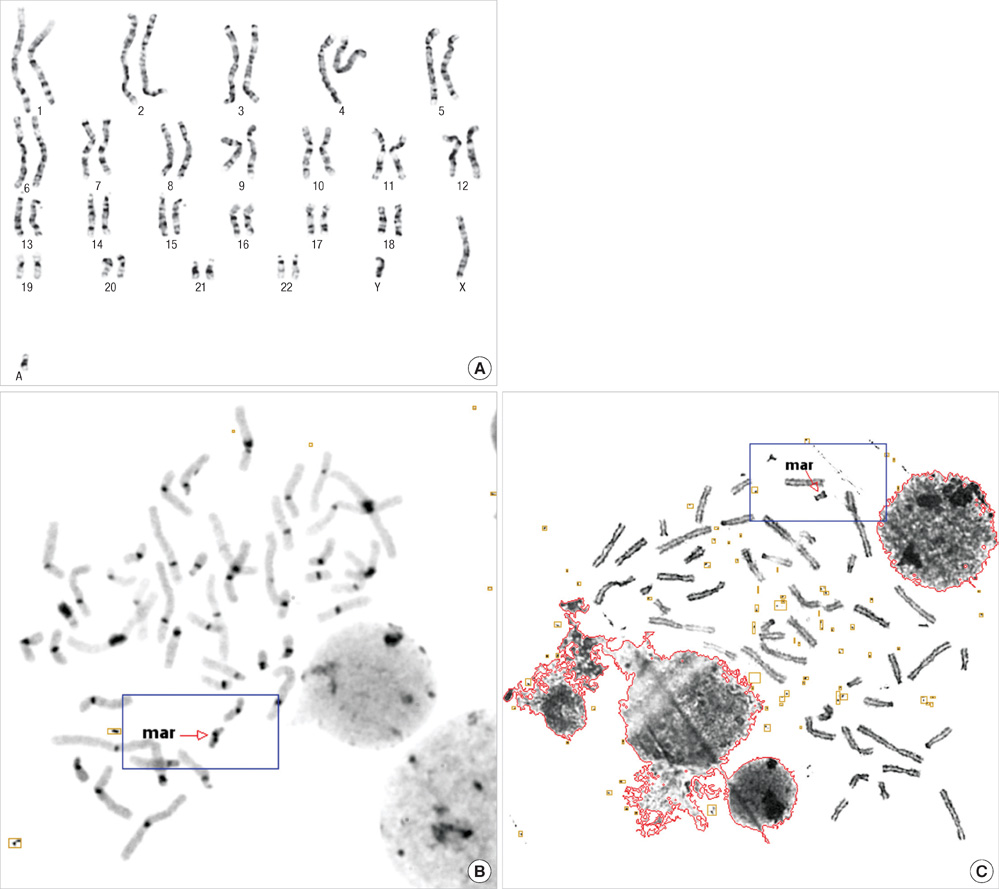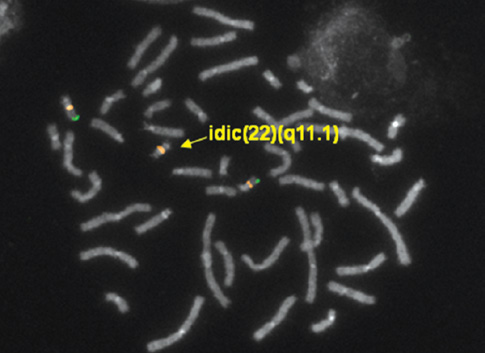J Korean Med Sci.
2010 Dec;25(12):1798-1801. 10.3346/jkms.2010.25.12.1798.
Partial Tetrasomy of Chromosome 22q11.1 Resulting from a Supernumerary Isodicentric Marker Chromosome in a Boy with Cat-eye Syndrome
- Affiliations
-
- 1Department of Medical Genetics, Ajou Medical Center, Ajou University School of Medicine, Suwon, Korea. jmko@ajou.ac.kr
- 2Department of Opthalmology, Ajou Medical Center, Ajou University School of Medicine, Suwon, Korea.
- 3Department of Pediatrics, Ajou Medical Center, Ajou University School of Medicine, Suwon, Korea.
- 4MG MED, Inc., Seoul, Korea.
- KMID: 1792906
- DOI: http://doi.org/10.3346/jkms.2010.25.12.1798
Abstract
- The 22q11 region has been implicated in chromosomal rearrangements that result in altered gene dosage, leading to three different congenital malformation syndromes: DiGeorge syndrome, cat-eye syndrome (CES), and der(22) syndrome. Although DiGeorge syndrome is a common genomic disorder on 22q11, CES is quite rare, and there has been no report of Korean CES cases with molecular cytogenetic confirmation. In this study, we present the phenotypic and genetic characteristics of a 3-month-old boy with CES. Clinical findings included micropthalmia, multiple colobomata, and renal and genital anomalies. Cytogenetic analyses showed the presence of a supernumerary marker chromosome, which was identified as a bisatellited and isodicentric chromosome derived from an acrocentric chromosome. The results of array comparative genomic hybridization and fluorescence in situ hybridization studies confirmed the karyotype as 47,XY,+mar.ish idic(22)(q11.1) (D22S43+).arr 22q11.1(15,500,000-15,900,000)x4, resulting in a partial tetrasomy of 22q11.1. To the best of our knowledge, this is the first report in Korea of CES confirmed by cytogenetic and molecular cytogenetic analyses.
MeSH Terms
Figure
Reference
-
1. Schinzel A, Schmid W, Fraccaro M, Tiepolo L, Zuffardi O, Opitz JM, Lindsten J, Zetterqvist P, Enell H, Baccichetti C, Tenconi R, Pagon RA. The "cat eye syndrome": dicentric small marker chromosome probably derived from a no22 (tetrasomy 22pter to q11) associated with a characteristic phenotype. Report of 11 patients and delineation of the clinical picture. Hum Genet. 1981. 57:148–158.
Article2. Berends MJ, Tan-Sindhunata G, Leegte B, van Essen AJ. Phenotypic variability of Cat-Eye syndrome. Genet Couns. 2001. 12:23–34.3. McDermid HE, Duncan AM, Brasch KR, Holden JJ, Magenis E, Sheehy R, Burn J, Kardon N, Noel B, Schinzel A, Teshima I, White BN. Characterization of the supernumerary chromosome in cat eye syndrome. Science. 1986. 232:646–648.
Article4. McDermid HE, Morrow BE. Genomic disorders on 22q11. Am J Hum Genet. 2002. 70:1077–1088.
Article5. Edelmann L, Pandita RK, Spiteri E, Funke B, Goldberg R, Palanisamy N, Chaganti RS, Magenis E, Shprintzen RJ, Morrow BE. A common molecular basis for rearrangement disorders on chromosome 22q11. Hum Mol Genet. 1999. 8:1157–1167.
Article6. Fraccaro M, Lindsten J, Ford CE, Iselius L. The 11q;22q translocation: a European collaborative analysis of 43 cases. Hum Genet. 1980. 56:21–51.7. Knoll JH, Asamoah A, Pletcher BA, Wagstaff J. Interstitial duplication of proximal 22q: phenotypic overlap with cat eye syndrome. Am J Med Genet. 1995. 55:221–224.
Article8. Lindsay EA, Shaffer LG, Carrozzo R, Greenberg F, Baldini A. De novo tandem duplication of chromosome segment 22q11-q12: clinical, cytogenetic, and molecular characterization. Am J Med Genet. 1995. 56:296–299.
Article9. Yang SH, Suh ES, Kim WT. A case of partial monosomy 10q with partial trisomy 22q due to maternal balanced translocation. J Korean Soc Neonatol. 2006. 13:288–293.10. Cullen P, Rodgers CS, Callen DF, Connolly VM, Eyre H, Fells P, Gordon H, Winter RM, Thakker RV. Association of familial Duane anomaly and urogenital abnormalities with a bisatellited marker derived from chromosome 22. Am J Med Genet. 1993. 47:925–930.
Article11. Rosias PR, Sijstermans JM, Theunissen PM, Pulles-Heintzberger CF, De Die-Smulders CE, Engelen JJ, Van Der Meer SB. Phenotypic variability of the cat eye syndrome. Case report and review of the literature. Genet Couns. 2001. 12:273–282.12. Mears AJ, Duncan AM, Budarf ML, Emanuel BS, Sellinger B, Siegel-Bartelt J, Greenberg CR, McDermid HE. Molecular characterization of the marker chromosome associated with cat eye syndrome. Am J Hum Genet. 1994. 55:134–142.13. Bartsch O, Rasi S, Hoffmann K, Blin N. FISH of supernumerary marker chromosomes (SMCs) identifies six diagnostically relevant intervals on chromosome 22q and a novel type of bisatellited SMC(22). Eur J Hum Genet. 2005. 13:592–598.
Article14. McTaggart KE, Budarf ML, Driscoll DA, Emanuel BS, Ferreira P, McDermid HE. Cat eye syndrome chromosome breakpoint clustering: identification of two intervals also associated with 22q11 deletion syndrome breakpoints. Cytogenet Cell Genet. 1998. 81:222–228.
Article15. Emanuel BS, Shaikh TH. Segmental duplications: an 'expanding' role in genomic instability and disease. Nat Rev Genet. 2001. 2:791–800.
Article16. Van Dyke DL, Weiss L, Logan M, Pai GS. The origin and behavior of two isodicentric bisatellited chromosomes. Am J Hum Genet. 1977. 29:294–300.17. Riazi MA, Brinkman-Mills P, Nguyen T, Pan H, Phan S, Ying F, Roe BA, Tochigi J, Shimizu Y, Minoshima S, Shimizu N, Buchwald M, McDermid HE. The human homolog of insect-derived growth factor, CECR1, is a candidate gene for features of cat eye syndrome. Genomics. 2000. 64:277–285.
Article18. Banting GS, Barak O, Ames TM, Burnham AC, Kardel MD, Cooch NS, Davidson CE, Godbout R, McDermid HE, Shiekhattar R. CECR2, a protein involved in neurulation, forms a novel chromatin remodeling complex with SNF2L. Hum Mol Genet. 2005. 14:513–524.
Article
- Full Text Links
- Actions
-
Cited
- CITED
-
- Close
- Share
- Similar articles
-
- Prenatal diagnosis of the isodicentric chromosome 22 associated with cat eye syndrome by multiplex ligation-dependent probe amplification
- A Case of Partial Monosomy 10q with Partial Trisomy 22q due to Maternal Balanced Translocation
- A Nine-Month-Old Boy With Isodicentric Chromosome 15: A Case Report
- Molecular Cytogenetic Characterization of Supernumerary Marker Chromosomes by Chromosomal Microarray
- A case of isodicentric chromosome 15 presented with epilepsy and developmental delay




